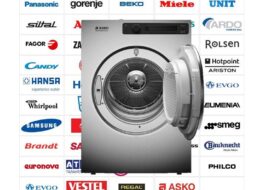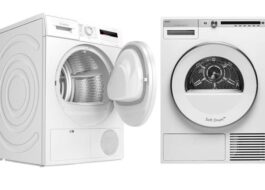Which dryer is better: heat pump or condensing?
 Currently, there are 3 types of these useful units on the drying machine market: ventilation, condensing, and heat pump options. The first type is almost impossible to find in stores due to the fact that it is endlessly outdated, but the second and third are in great demand today. Therefore, buyers are faced with a difficult choice - a heat pump dryer or a condenser dryer, that is the question. To help you with your choice, we have prepared an article in which we will tell you which is better.
Currently, there are 3 types of these useful units on the drying machine market: ventilation, condensing, and heat pump options. The first type is almost impossible to find in stores due to the fact that it is endlessly outdated, but the second and third are in great demand today. Therefore, buyers are faced with a difficult choice - a heat pump dryer or a condenser dryer, that is the question. To help you with your choice, we have prepared an article in which we will tell you which is better.
About the structure and operation of a condensation dryer
Condenser dryers help housewives dry things without connecting to a water supply. Their main feature is that the device only needs to be connected to the mains to start drying clothes. There are unique models, such as Gorenje DP7B, which can additionally be connected to a water supply to drain condensate, but this is rather an exception to the rule.
Such units consist of a number of components.
- Drum for loading things. During drying, it rotates with the help of a motor and a drive belt, due to which things are evenly dried due to the incoming warm air.
- A heating element that heats the air inside the dryer.
- A hair dryer that allows hot air to circulate through the drum of the machine.
- A pump necessary for pumping out condensate.
- Tank where condensate is stored.

This dryer works as follows:
- The heating element significantly increases the air temperature inside the device;
- the hair dryer helps the heated air enter the drum of the device;
- the high temperature in the device causes moisture to evaporate from the laundry;
- the pump removes moisture into a special tank, where it settles in the form of water;
- The dryer begins to heat the air again to repeat the procedure from scratch until all the clothes are dry.
Depending on the model, the following additional features may be available to customers:
- drying clothes made of different materials, such as cotton, wool, jeans, etc.;
- drying to a certain level so that the clothes are completely dry or ready for ironing;
- delicate drying;
- accelerated work;
- timer for control;
- easy ironing or anti-creasing of clothes;
- delayed start;
- drying shoes and outerwear.

A huge advantage of such dryers is their unpretentiousness in operation. They are easy to install and even easier to use. It is enough just to regularly clean the condensate container when the machine reports that it is full, and also clean the lint filter, which can only be done once every few weeks, provided that the unit is actively used.
If you connect the machine to the water supply, you won’t even have to clean the condensate tank; all you have to do is occasionally clean it in the lint filter.
The main disadvantage of condensing dryers is considered to be increased energy consumption. Due to the fact that this home assistant must constantly maintain a high air temperature, it consumes a lot of electricity. Therefore, it is worth considering before purchasing whether you are ready for a serious increase in electricity bills, or whether it is better to look at a more economical model.
Equipment equipped with heat pumps
Machines with a heat pump are modern devices that combine two types of moisture removal – condensation and ventilation. In such models, moist air after the drying cycle is not removed from the dryer. The device passes such air through a heat pump to be reused later. Thus, the moisture either remains in the tank or goes down the drain, and the previously used air begins to heat up again in order to continue processing the laundry.
A huge advantage of devices with such a system is the implementation of a closed heat exchange system. Such a device takes in and heats air masses much less frequently, therefore it consumes less electricity and allows users to save on the drying procedure.
The design of such devices is more complex than those described above.
- The drum for clothes, which, as in condensing dryer options, rotates using a motor and a drive belt.
- The evaporator is the area at the bottom of the unit where the air loses moisture and becomes cooler so it can be reused.
- A pump with a condenser in which the air is heated again.
- A fan necessary to redirect warm air into the clothing compartment.

The full operating cycle of the device consists of the following points.
- The condenser heats the air.
- The fan redirects heated air into the drum towards wet clothes.
- Clothes dry, hot air causes moisture to evaporate.
- The humid air passes into the evaporator, loses moisture and cools. The condensate goes either into the water supply or into a container.
- Dry air goes back into the pump, and then the working cycle begins again.
Machines with a heat pump dry clothes more delicately, since the temperature of the heated air usually reaches only 40 degrees Celsius and does not harm things made of any type of fabric.
The low temperature is also maintained in the evaporator - only 15-20 degrees. In addition, the treated stream of moist air does not cool down very much - the temperature usually drops to only 30 degrees. Because of this, the air re-enters the pump not very cold, so it heats up faster.
The heat pump dryer has been specially designed to be more gentle on everything – both your clothes and your energy consumption. It helps you save on energy bills and dries things more gently. But due to its responsible attitude towards the environment, such a dryer is much more expensive than condensing models.
Making a device selection
After this article, questions about which is better, a heat pump dryer or a condenser dryer, should disappear by themselves. The current situation is that the first type of dryer is far ahead of any other type of dryer.
This machine gently dries laundry and clothes, which is why they remain in good condition longer. It doesn't waste a lot of electricity, helps you save on electricity bills, and doesn't put a strain on the network, so there's virtually no risk of a short circuit when using it. Finally, modern models are provided with a number of useful programs and functions that will make drying things simple and convenient.
It has exactly two obvious disadvantages, and both stem from the complex design of the unit. High-tech devices always cost more than their conventional counterparts, so it’s not surprising that you’ll have to pay a hefty sum for a model with a pump.In addition, it is not always easy to find spare parts for such dryers and a technician who can help with repairs. But if you close your eyes to these disadvantages, it becomes obvious that a heat pump dryer is much better than a regular condenser dryer.
Interesting:
Reader comments
- Share your opinion - leave a comment




















Add a comment